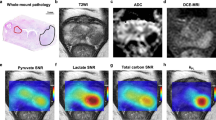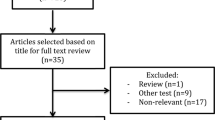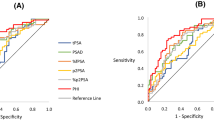Abstract
Background:
Annual PSA tests have led to a significant increase in the number of prostate cancer (PCa) cases diagnosed. This increased incidence has led to overtreatment of many patients, as current pathology often cannot distinguish latent from aggressive PCa. Studies have shown that the depletion of zinc in prostate cells correlated with cell-line growth rates, and may therefore relate to the progression of PCa. Furthermore, as zinc is normally an inhibitor of citrate oxidation, the reduction of zinc in PCa may cause a decrease in citrate secretion levels in the glandular epithelia of PCa patients.
Methods:
Using high-resolution magic angle spinning proton magnetic resonance spectroscopy followed by quantitative histopathology, we investigate unit histo-benign prostate epithelial citrate concentrations in intact tissue samples obtained from 18 patients with pre-surgical PSA values less than 20 ng/ml. Using these data, we evaluate correlations between citrate concentrations and PSA velocities, densities and blood percent-free PSA.
Results:
We observe different linear patterns between citrate concentrations and histo-benign glandular epithelia from patients of different PSA velocities. More importantly, we obtain a significant correlation between PSA velocity, density and percent-free PSA, and citrate concentrations in unit volume of histo-benign epithelial glands of the peripheral zone.
Conclusions:
Low levels of citrate in unit volume represent rapidly increasing PSA values, and, therefore, may be used as an indicator of fast-growing PCa. Thus, tissue samples obtained at the time of biopsy may be evaluated for their citrate concentrations for the prediction of PCa growth rates, allowing for the implementation of alternative treatment options and reducing overtreatment.
This is a preview of subscription content, access via your institution
Access options
Subscribe to this journal
Receive 4 print issues and online access
$259.00 per year
only $64.75 per issue
Buy this article
- Purchase on Springer Link
- Instant access to full article PDF
Prices may be subject to local taxes which are calculated during checkout



Similar content being viewed by others
References
Andriole GL, Crawford ED, Grubb III RL, Buys SS, Chia D, Church TR et al. Mortality results from a randomized prostate-cancer screening trial. N Engl J Med 2009; 360: 1310–1319.
Jemal A, Bray F, Center MM, Ferlay J, Ward E, Forman D . Global cancer statistics. CA Cancer J Clin 2010; 61: 69–90.
Epstein JI . An update of the Gleason grading system. J Urol 2010; 183: 433–440.
Han M, Partin AW, Zahurak M, Piantadosi S, Epstein JI, Walsh PC . Biochemical (prostate specific antigen) recurrence probability following radical prostatectomy for clinically localized prostate cancer. J Urol 2003; 169: 517–523.
Klotz L . Active surveillance versus radical treatment for favorable-risk localized prostate cancer. Curr Treat Options Oncol 2006; 7: 355–362.
Hall MJ, DeFrances CJ, Williams SN, Golosinskiy A, Schwartzman A . National Hospital Discharge Survey: 2007 summary. Natl Health Stat Report 2010; 29: 1–20, 24.
Gore JL, Kwan L, Lee SP, Reiter RE, Litwin MS . Survivorship beyond convalescence: 48-month quality-of-life outcomes after treatment for localized prostate cancer. J Natl Cancer Inst 2009; 101: 888–892.
Fradet Y . Biomarkers in prostate cancer diagnosis and prognosis: beyond prostate-specific antigen. Curr Opin Urol 2009; 19: 243–246.
Fiorentino M, Capizzi E, Loda M . Blood and tissue biomarkers in prostate cancer: state of the art. Urol Clin North Am 2010; 37: 131–141, Table of Contents.
Ploussard G, de la Taille A . Urine biomarkers in prostate cancer. Nat Rev Urol 2010; 7: 101–109.
Sardana G, Dowell B, Diamandis EP . Emerging biomarkers for the diagnosis and prognosis of prostate cancer. Clin Chem 2008; 54: 1951–1960.
Swanson GP, Basler JW . Prognostic factors for failure after prostatectomy. J Cancer 2010; 2: 1–19.
Franklin RB, Feng P, Milon B, Desouki MM, Singh KK, Kajdacsy-Balla A et al. hZIP1 zinc uptake transporter down regulation and zinc depletion in prostate cancer. Mol Cancer 2005; 4: 32.
Costello LC, Franklin RB, Feng P, Tan M, Bagasra O . Zinc and prostate cancer: a critical scientific, medical, and public interest issue (United States). Cancer Causes Control 2005; 16: 901–915.
Huang L, Kirschke CP, Zhang Y . Decreased intracellular zinc in human tumorigenic prostate epithelial cells: a possible role in prostate cancer progression. Cancer Cell Int 2006; 6: 10.
Golovine K, Makhov P, Uzzo RG, Shaw T, Kunkle D, Kolenko VM . Overexpression of the zinc uptake transporter hZIP1 inhibits nuclear factor-kappaB and reduces the malignant potential of prostate cancer cells in vitro and in vivo. Clin Cancer Res 2008; 14: 5376–5384.
Makhov P, Golovine K, Uzzo RG, Wuestefeld T, Scoll BJ, Kolenko VM . Transcriptional regulation of the major zinc uptake protein hZip1 in prostate cancer cells. Gene 2009; 431: 39–46.
Ghosh SK, Kim P, Zhang XA, Yun SH, Moore A, Lippard SJ et al. A novel imaging approach for early detection of prostate cancer based on endogenous zinc sensing. Cancer Res 2010; 70: 6119–6127.
Cortesi M, Fridman E, Volkov A, Shilstein S, Chechik R, Breskin A et al. New prospective for non-invasive detection, grading, size evaluation, and tumor location of prostate cancer. Prostate 2010; 70: 1701–1708.
Zaichick V, Sviridova TV, Zaichick SV . Zinc in the human prostate gland: normal, hyperplastic and cancerous. Int Urol Nephrol 1997; 29: 565–574.
Costello LC, Franklin RB . Prostatic fluid electrolyte composition for the screening of prostate cancer: a potential solution to a major problem. Prostate Cancer Prostatic Dis 2009; 12: 17–24.
Costello LC, Liu Y, Franklin RB, Kennedy MC . Zinc inhibition of mitochondrial aconitase and its importance in citrate metabolism of prostate epithelial cells. J Biol Chem 1997; 272: 28875–28881.
Cheng LL, Burns MA, Taylor JL, He W, Halpern EF, McDougal WS et al. Metabolic characterization of human prostate cancer with tissue magnetic resonance spectroscopy. Cancer Res 2005; 65: 3030–3034.
Serkova NJ, Gamito EJ, Jones RH, O'Donnell C, Brown JL, Green S et al. The metabolites citrate, myo-inositol, and spermine are potential age-independent markers of prostate cancer in human expressed prostatic secretions. Prostate 2008; 68: 620–628.
Mueller-Lisse UG, Scherr MK . Proton MR spectroscopy of the prostate. Eur J Radiol 2007; 63: 351–360.
Cheng LL, Ma MJ, Becerra L, Ptak T, Tracey I, Lackner A et al. Quantitative neuropathology by high resolution magic angle spinning proton magnetic resonance spectroscopy. Proc Natl Acad Sci USA 1997; 94: 6408–6413.
Burns MA, Taylor JL, Wu CL, Zepeda AG, Bielecki A, Cory D et al. Reduction of spinning sidebands in proton NMR of human prostate tissue with slow high-resolution magic angle spinning. Magn Reson Med 2005; 54: 34–42.
Cheng LL, Wu C, Smith MR, Gonzalez RG . Non-destructive quantitation of spermine in human prostate tissue samples using HRMAS 1H NMR spectroscopy at 9.4T. FEBS Lett 2001; 494: 112–116.
Rhodes DR, Sanda MG, Otte AP, Chinnaiyan AM, Rubin MA . Multiplex biomarker approach for determining risk of prostate-specific antigen-defined recurrence of prostate cancer. J Natl Cancer Inst 2003; 95: 661–668.
Ross AE, Loeb S, Landis P, Partin AW, Epstein JI, Kettermann A et al. Prostate-specific antigen kinetics during follow-up are an unreliable trigger for intervention in a prostate cancer surveillance program. J Clin Oncol 2010; 28: 2810–2816.
Coen JJ, Feldman AS, Smith MR, Zietman AL . Watchful waiting for localized prostate cancer in the PSA era: what have been the triggers for intervention? BJU Int 2011; 107: 1582–1586.
Smith AD, Phillips JL . Limitations and use of PSA velocity in the diagnosis and characterization of prostate cancer. Nat Clin Pract Urol 2007; 4: 576–577.
Yu X, Loeb S, Roehl KA, Han M, Catalona WJ . The association between total prostate specific antigen concentration and prostate specific antigen velocity. J Urol 2007; 177: 1298–1302; discussion 1298–1302.
Berger AP, Deibl M, Steiner H, Bektic J, Pelzer A, Spranger R et al. Longitudinal PSA changes in men with and without prostate cancer: assessment of prostate cancer risk. Prostate 2005; 64: 240–245.
Qian F, Zhang C, Zhang Y, He W, Gao X, Hu P et al. Visible light excitable Zn2+ fluorescent sensor derived from an intramolecular charge transfer fluorophore and its in vitro and in vivo application. J Am Chem Soc 2009; 131: 1460–1468.
Acknowledgements
This work was supported by PHS/NIH grants CA115746, CA115746S2, CA162959, and CA141139 (LLC), and MGH A.A. Martinos Center for Biomedical Imaging.
Author information
Authors and Affiliations
Corresponding author
Ethics declarations
Competing interests
The authors declare no conflict of interest.
Rights and permissions
About this article
Cite this article
Dittrich, R., Kurth, J., Decelle, E. et al. Assessing prostate cancer growth with citrate measured by intact tissue proton magnetic resonance spectroscopy. Prostate Cancer Prostatic Dis 15, 278–282 (2012). https://doi.org/10.1038/pcan.2011.70
Received:
Revised:
Accepted:
Published:
Issue Date:
DOI: https://doi.org/10.1038/pcan.2011.70
Keywords
This article is cited by
-
High resolution magic angle spinning MRS in prostate cancer
Magnetic Resonance Materials in Physics, Biology and Medicine (2022)
-
Metabolomic Prediction of Human Prostate Cancer Aggressiveness: Magnetic Resonance Spectroscopy of Histologically Benign Tissue
Scientific Reports (2018)
-
NMR-based metabolomics studies of human prostate cancer tissue
Metabolomics (2018)
-
The fast Padé transform for noisy magnetic resonance spectroscopic data from the prostate: potential contribution to individualized prostate cancer care
Journal of Mathematical Chemistry (2016)
-
Metabolomic imaging of prostate cancer with magnetic resonance spectroscopy and mass spectrometry
European Journal of Nuclear Medicine and Molecular Imaging (2013)



